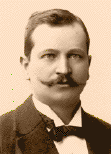Problem 1
In this problem you will derive the dispersion relation and other properties of the surface plasmon!
Consider a metal with a surface in the xy plane, i.e. z > 0 is metal and z < 0 is the vacuum. The surface plasmon is a solution to Maxwell's equations of the form,
Ex = Aeiqx e−Kze−iωt, Ey =0, Ez = Beiqxe−Kze−iωt for z > 0
Ex = Ceiqx eK'ze−iωt, Ey =0, Ez = DeiqxeK'ze−iωt for z < 0
with q, K, K' real and K, K' positive (so that the amplidue of the wave decays as z moves away from z=0).
Assume that there is no charge density induced in the bulk of the metal, i.e. ∇⋅E=0, (but there may be induced surface charge).
By requiring the above expression to satisfy Maxwell's equation, and to satisfy the usual electromagnetic boundary conditions, tangential component of E continuous and normal component of εE continuous, find equations relating the unknown amplitudes A, B, C, D to each other, and relating q, K, K' to each other and to the frequency ω.
Use for the metal the dielectric function ε(ω) = 1+4πiσ(ω)/ω, with σ(ω) the ac Drude conductivity. You may make the assumption that ωτ >> 1 so that ε(ω) ≈ 1 − (ωP/ω)2, where ωP=4πne2/m is the plasma frequency.
Use your results above to solve for q as a function of ω. Plot q2c2 vs ω2, and indicate for what range of ω there is indeed a solution with the desired properties.
Compute the surface charge density induced on the surface of the metal? (Hint: remember your electrostatics!)
What is the dispersion relation ω(q) in the limit of small q? Show that as q gets very large (i.e. qc >> ω) there is a solution at frequency ω = ωP/√2. What is the polarization of this wave when ω = ωP/√2?
Problem 2
(Ashcroft & Mermin problem 4.1)
In each of the following cases indicate whether the structure is a Bravais lattice. If it is, give three primitive vectors; if it is not, describe it as a Bravais lattice with as small a basis as possible.
a) Base-centered cubic (simple cubic with additional points in the centers of the horizontal faces of the cubic cell).
b) Side-centered cubic (simple cubic with additional points in the centers of the vertical faces of the cubic cell).
c) Edge-centered cubic (simple cubic with additional points at the midpoints of the lines joining nearest neighbors).
